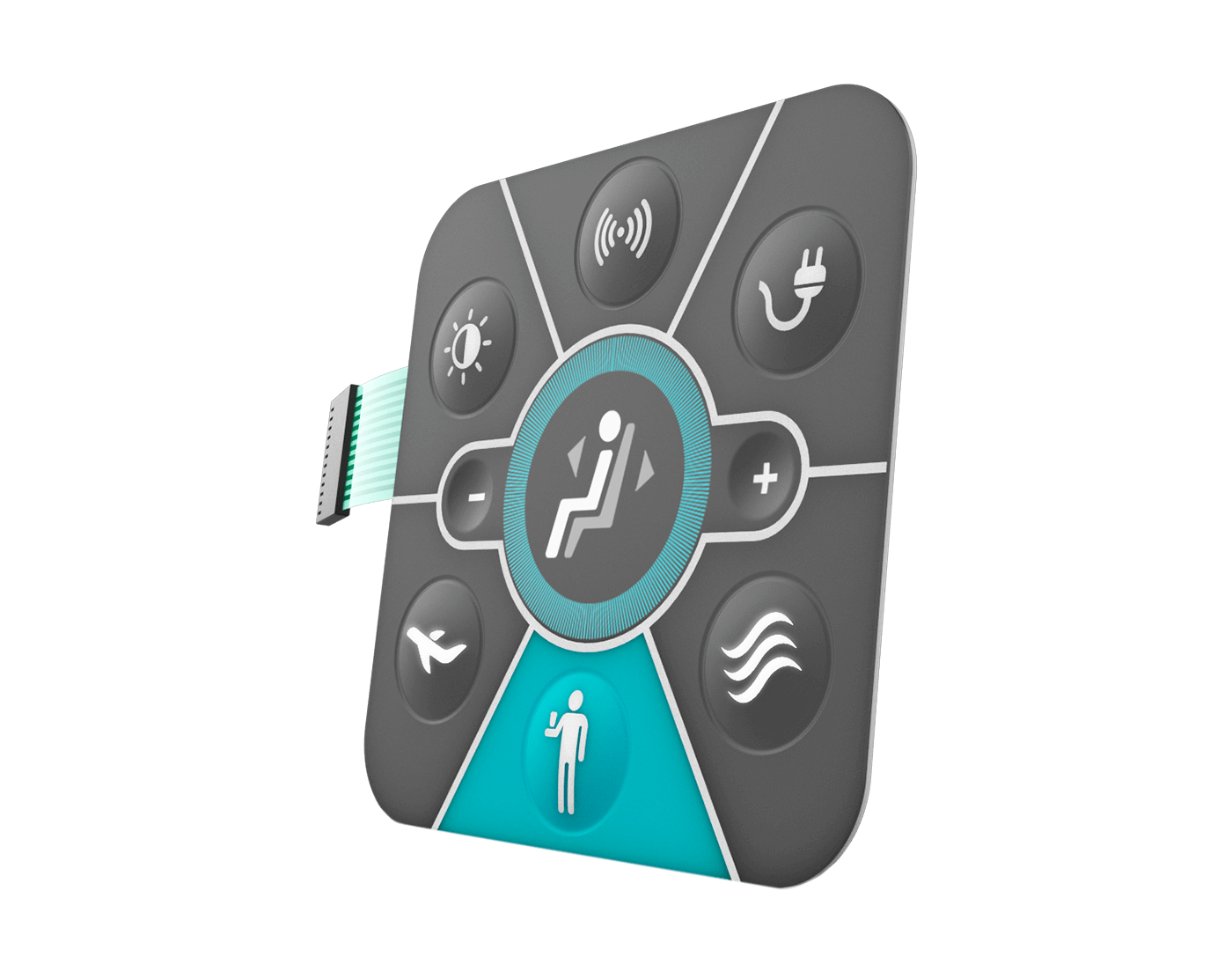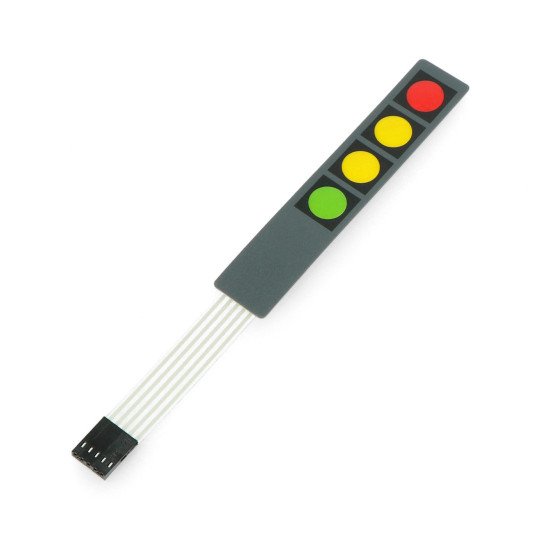Full-Service Membrane Switch Manufacturer for Niche Applications
Full-Service Membrane Switch Manufacturer for Niche Applications
Blog Article
Exactly How Membrane Switch Modern Technology Functions and Its Duty in Individual Interface Layout
Membrane switch innovation is a sophisticated method that combines split materials for touch-sensitive input. When pressed, its style consists of graphic overlays, conductive layers, and adhesive components that interact. This communication not only completes an electrical circuit but also influences the general user experience. Understanding the intricacies of this innovation exposes its significant influence on user interface layout, prompting inquiries concerning its applications and future advancements in different sectors.
Comprehending Membrane Switch Technology
Membrane switch innovation serves as a critical element in modern-day interface layout. This technology incorporates visuals overlays, touch-sensitive membrane layers, and circuit layers to create a compact, reputable input method for numerous gadgets. The style commonly contains numerous layers, including a published graphic layer that enables customers to interact with the gadget via tactile feedback. Membrane buttons are known for their durability, resistance to wetness, and convenience of cleansing, making them ideal for environments where traditional mechanical switches might fall short. Their low-profile layout enables seamless integration into gadgets, adding to a streamlined look. On top of that, Membrane switches can be customized with various shades, textures, and icons, enhancing user experience and visual appeal. This flexibility makes them popular in consumer electronics, clinical tools, and commercial controls, where intuitive interaction is essential. Generally, Membrane button modern technology stands for a significant development in just how customers engage with electronic interfaces.
Trick Components of Membrane Switches Over
Membrane switches over include several essential components that add to their performance and design. The conductive layer products, sticky and support layers, and graphic overlay style each play an important duty in making certain suitable efficiency and individual interaction. Comprehending these components is vital for reliable interface style.
Conductive Layer Materials
Conductive layer materials play an important role in the functionality and dependability of Membrane buttons. When stress is applied to the button, these materials are responsible for finishing electric circuits. Usually, a combination of conductive inks, such as silver or carbon, is made use of to develop these layers. Silver conductive ink is favored for its premium conductivity and resilience, while carbon ink is frequently used for cost-efficient applications. The choice of product impacts not only the electrical efficiency yet additionally the general life-span of the button. Additionally, the thickness and structure of conductive layers can influence responsive feedback and switch actuation. Selecting the appropriate conductive material is important for guaranteeing perfect performance in diverse interface applications.
Sticky and Assistance Layers
Sticky and assistance layers are important parts that add to the structural honesty and capability of Membrane switches. These layers offer a robust foundation, ensuring that the different components of the Membrane button stay firmly bonded and effectively aligned throughout their functional life. The adhesive layer assists in the attachment of the switch to the underlying surface area, supplying toughness versus environmental elements such as moisture, temperature variations, and mechanical stress and anxiety. Support layers improve the button's rigidness, stopping deformation throughout usage and adding to a consistent tactile action. With each other, these parts play a crucial function in keeping the efficiency and long life of Membrane buttons, eventually affecting the total customer experience in interface layout.
Graphic Overlay Design
Often forgotten, graphic overlay design plays a vital role in the performance and aesthetics of Membrane switches. This layout mainly functions as the user interface in between the individual and the electronics, offering both aesthetic charm and functional clarity. Efficient graphic overlays use shade, typography, and symbols to assist users in understanding and maneuvering controls device features. In addition, the choice of materials effects durability and tactile comments, ensuring the overlay withstands wear while maintaining a positive user experience. Additionally, precise positioning of the overlay with the underlying elements is essential for excellent performance. To conclude, thoughtful graphic overlay design boosts usability, adds to brand name identity, and eventually influences user complete satisfaction in tools utilizing Membrane switch innovation.
The Manufacturing Process of Membrane Changes
The manufacturing process of Membrane switches over involves numerous vital actions that guarantee capability and longevity. A graphic overlay is designed, incorporating customer interface components and branding. This overlay is published onto an adaptable substratum, typically polyester or polycarbonate, using precision printing techniques to ascertain quality and color accuracy.Next, adhesive layers are applied, adhered to by the assimilation of conductive traces, usually made from silver or carbon, which are crucial for electrical connectivity. These traces are screen-printed or etched onto a different layer. Hereafter, a spacer layer is added to develop the needed void between the circuit and the overlay layer, enabling for tactile feedback when activated.Finally, the parts are constructed and examined for high quality assurance, ensuring that each Membrane switch satisfies the required requirements for efficiency and dependability. This meticulous process causes a robust item matched for numerous applications in user interface style.
Advantages of Utilizing Membrane Switches Over

Membrane switches over deal numerous advantages that make them a recommended option in individual interface design. One substantial benefit is their light-weight and small nature, enabling for streamlined designs in various applications. In addition, Membrane switches give a sealed interface, safeguarding versus dirt, find out here moisture, and impurities, which enhances toughness and reliability. They are also very adjustable, making it possible for designers to create distinct graphics and layouts customized to particular customer needs.Another benefit is their cost-effectiveness, as they normally call for much less product and labor compared to conventional buttons. The tactile responses of Membrane buttons can be crafted to boost user experience, providing a satisfying action without the bulk of mechanical components. Membrane buttons can be conveniently integrated into varied atmospheres, such as medical tools, commercial devices, and customer electronics. Overall, these advantages highlight the growing appeal of Membrane switches in modern user interface design.
Applications in Numerous Industries
Commonly used across different markets, Membrane switch technology has discovered its location in applications ranging from clinical devices to consumer electronic devices. In the health care industry, these buttons are integral to gadgets such as analysis tools and person monitoring systems, providing resilient, easy-to-clean user interfaces that endure sanitation procedures. The vehicle industry uses Membrane buttons in dashboards and control panels, offering dependable operation in difficult environments.Consumer electronic devices, including home devices and pc gaming consoles, take advantage of the smooth design and customizability of Membrane switches, enhancing customer interaction. Additionally, commercial equipment makes use of these buttons for control panels, making certain resistance to dirt and moisture while preserving functionality.Moreover, the aerospace and military industries use Membrane buttons for tough applications, where dependability and efficiency are crucial. Overall, Membrane switch innovation offers varied markets by integrating capability, longevity, and aesthetic appeal, making it a versatile selection for modern-day interface.

Designing Interface With Membrane Switches Over
When designing interface with Membrane switches, careful factor to consider of both capability and visual appeal is necessary. Membrane switches over use a streamlined, low-profile style that can boost aesthetic appeal while preserving usability. Developers should concentrate on switch layout, making certain intuitive positioning for ease of operation. The responsive feedback given by the Membrane button is crucial; it can impact customer satisfaction and total experience.Additionally, shade and graphic aspects must straighten with the brand name identity, strengthening recognition and knowledge. Selecting resilient products that endure wear and tear is also vital, as durability contributes to functionality with time. Integrating backlighting can enhance presence in numerous lights conditions, even more boosting customer interaction. Ultimately, a properly designed Membrane switch user interface balances both kind and feature, making sure that the customer experience is both appealing and reliable, satisfying the needs of diverse applications throughout industries.
Future Patterns in Membrane Switch Modern Technology
As Membrane button innovation progresses, the combination of clever capabilities is coming to be progressively noticeable. These improvements make it possible for improved interactivity and connectivity within individual interfaces (membrane switch manufacturer). Additionally, the shift towards green materials shows an check my reference expanding dedication to sustainability in design techniques
Smart Membrane Switches Over

Eco-Friendly Products Usage
Among the developments in Membrane switch modern technology, a substantial fad is arising towards using environmentally friendly products. Suppliers are increasingly focusing on sustainability by integrating biodegradable plastics and non-toxic inks, minimizing ecological effect. This change not just lines up with global ecological criteria yet likewise addresses customer demand for greener items. recommended you read Innovations in material scientific research have actually made it possible for the growth of sturdy, environmentally friendly choices that preserve performance without compromising quality. These materials use equivalent functionality to traditional alternatives while reducing waste and poisoning. As markets become much more eco-conscious, the combination of sustainable methods in Membrane button manufacturing is anticipated to climb, enhancing a commitment to ecological duty and paving the means for even more sustainable interface options in the future.
Often Asked Inquiries
Exactly How Do Membrane Changes Differ From Typical Mechanical Buttons?
Membrane changes differ from traditional mechanical switches primarily in building and construction and operation. They make use of adaptable layers that develop a secured interface, whereas mechanical switches count on physical motion and call, resulting in distinct longevity and responsive responses features.
Can Membrane Switches Be Custom-made for Details Applications?
Membrane switches can undoubtedly be tailored for certain applications - membrane switch manufacturer. Manufacturers make them to fulfill one-of-a-kind demands, enabling for tailored designs, graphics, and performances that boost user communication and fit certain operational demands efficiently
What Is the Lifespan of a Membrane Layer Switch?
The life expectancy of a membrane layer switch normally ranges from 1 to 5 million actuations, relying on factors such as worldly quality, ecological problems, and usage regularity. Normal testing can help determine its longevity and reliability in applications.
Are Membrane Changes Water-proof or Immune to Chemicals?
Membrane switches can be created to be water-proof and immune to chemicals, depending on the materials made use of and making processes. Correct securing and safety coatings boost their toughness in numerous environmental problems and applications.
Just How Do Membrane Changes Impact Gadget Power Consumption?
Membrane buttons can considerably affect gadget power consumption by making certain efficient procedure. Their low power requirements during activation help decrease power use, adding to longer battery life and overall enhanced performance in electronic tools. Membrane switches are understood for their resilience, resistance to dampness, and convenience of cleaning, making them ideal for atmospheres where conventional mechanical switches may stop working. The automotive industry uses Membrane buttons in control panels and control panels, offering reputable procedure in challenging environments.Consumer electronics, consisting of home appliances and pc gaming consoles, advantage from the sleek design and customizability of Membrane switches, boosting individual interaction. Furthermore, industrial machinery makes use of these buttons for control panels, ensuring resistance to dust and wetness while preserving functionality.Moreover, the aerospace and armed forces markets make use of Membrane switches for rugged applications, where integrity and performance are vital. The development of Membrane switch modern technology is going into an exciting stage with the introduction of wise Membrane switches, which integrate sophisticated features and functionalities. Membrane switches vary from conventional mechanical switches largely in construction and operation.
Report this page